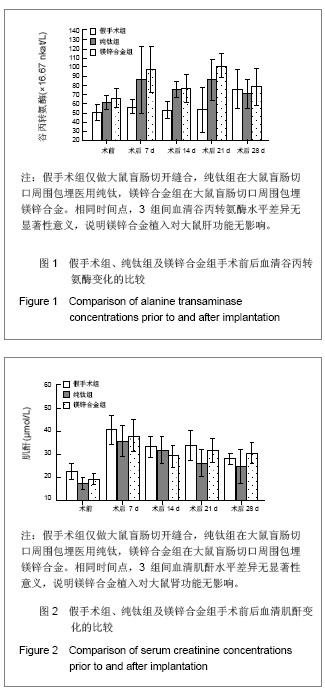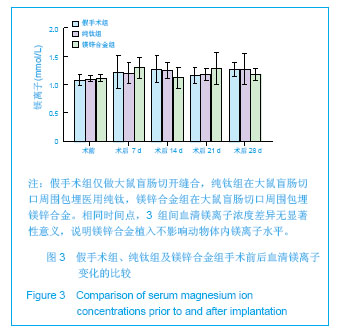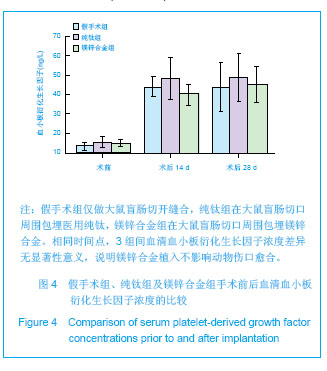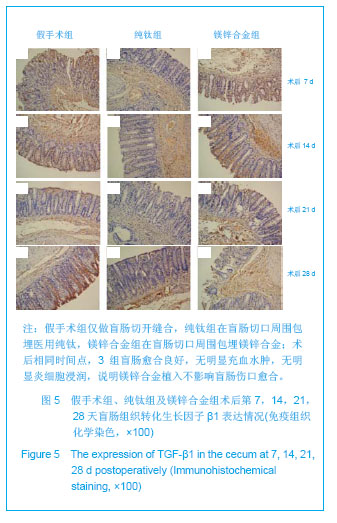| [1]Song GL.Control of biodegradation of biocompatable magnesium alloys. Corros Sci.2007;49(4): 1696-1701.[2]Atrens A,Liu M,Zainal Abidin NI.Corrosion mechanism applicable to biodegradable magnesium implants. Mater Sci Eng B.2011;16(20):1609-1636.[3]Gu X,Zheng Y,Cheng Y,et al.In vitro corrosion and biocompatibility of binary magnesium alloys.Biomaterials. 2009;30(4): 484-498.[4]Xu L,Zhang E,Yang K.Phosphating treatment and corrosion properties of Mg-Mn-Zn alloy for biomedical application.J Mater Sci Mater Med. 2009;20(4): 859-867.[5]Xin Y,Liu C,Huo K,et al. Corrosion behavior of ZrN/Zr coated biomedical AZ91 magnesium alloy. Surf Coat Technol. 2009; 203(17-18): 2554-2557.[6]Xu L,Pan F,Yu G,et al.In vitro and in vivo evaluation of the surface bioactivity of a calcium phosphate coated magnesium alloy. Biomaterials.2009;30(8): 1512-1523.[7]Zhang S,Zhang X,Zhao C,et al.Research on an Mg-Zn alloy as a degradable biomaterial. Acta Biomaterialia. 2010;6(2): 626-640.[8]Zhang S,Li J,Song Y,et al.In vitro degradation, hemolysis and MC3T3-E1 cell adhesion of biodegradable Mg-Zn alloy. Mater Sci Eng C. 2009;29(6): 1907-1912.[9]The Ministry of Science and Technology of the People’s Republic of China. Guidance suggestion of caring laboratory animals.2006-09-30.中华人民共和国科学技术部. 关于善待实验动物的指导性意见. 2006-09-30[10]Jia G,Zhang M,Wu X. Repair effect of BMSCs on digestive tract injury. Zhongguo Xiu Fu Chong Jian Wai Ke Za Zhi. 2009;23(6):751-754.[11]Dignass AU. Mechanisms and modulation of intestinal epithelial repair. Inflamm Bowel Dis. 2001;7(1): 68-77.[12]Sturm A,Dignass AU.Epithelial restitution and wound healing in inflammatory bowel disease. World J Gastroenterol. 2008; 14(3): 348-353.[13]Kondo T,Ishida Y.Molecular pathology of wound healing. Forensic Sci Int. 2010;203(1-3): 93-98.[14]Karrasch T,Jobin C.Wound healing responses at the gastrointestinal epithelium: a close look at novel regulatory factors and investigative approaches. Z Gastroenterol. 2009;47(12):1221-1229. [15]Turner JR. Intestinal mucosal barrier function in health and disease. Nat Rev Immunol. 2009;9(11):799-809. [16]Powell N,Walker MM,Talley NJ.Gastrointestinal eosinophils in health, disease and functional disorders.Nat Rev Gastroenterol Hepatol.2010; 7(3):146-156.[17]Iizuka M,Konno S.Wound healing of intestinal epithelial cells. World J Gastroenterol. 2011;17(17):2161-2171.[18]Werner S,Grose R.Regulation of wound healing by growth factors and cytokines. Physiol Rev.2003;83(3):835-870.[19]Janis JE,Kwon RK,Lalonde DH. A practical guide to wound healing. Plast Reconstr Surg. 2010;125(6): 230e-244e.[20]Dignass AU,Sturm A.Peptide growth factors in the intestine. Eur J Gastroenterol Hepatol.2001;13(7): 763-770.[21]Barrientos S,Stojadinovic O,Golinko MS,et al. Growth factors and cytokines in wound healing. Wound Repair Regen.2008; 16(5): 585-601.[22]Chung R,Foster BK,Xian CJ. Injury responses and repair mechanisms of the injured growth plate. Front Biosci (Schol Ed).2011;3:117-125.[23]Diegelmann RF,Evans MC.Wound healing: an overview of acute, fibrotic and delayed healing. Front Biosci.2004;9: 283-289.[24]Kaigler D,Avila G,Wisner-Lynch L,et al.Platelet-derived growth factor applications in periodontal and peri-implant bone regeneration. Expert Opin Biol Ther.2011;11(3):375-385.[25]Walsh MF,Ampasala DR,Rishi AK,et al. TGF-beta1 modulates focal adhesion kinase expression in rat intestinal epithelial IEC-6 cells via stimulatory and inhibitory Smad binding elements. Biochim Biophys Acta.2009;1789(2):88-98. [26]Barreto A,Rodríguez LS,Rojas OL,et al.Membrane vesicles released by intestinal epithelial cells infected with rotavirus inhibit T-cell function. Viral Immunol.2010;23(6):595-608.[27]Mithani SK,Balch GC,Shiou SR,et al.Smad3 has a critical role in TGF-beta-mediated growth inhibition and apoptosis in colonic epithelial cells. J Surg Res.2004;117(2): 296-305.[28]Howe KL,Reardon C,Wang A,et al. Transforming growth factor-beta regulation of epithelial tight junction proteins enhances barrier function and blocks enterohemorrhagic Escherichia coli O157:H7-induced increased permeability. Am J Pathol.2005;167(6): 1587-1597.[29]Denkena B,Lucas A.Biocompatible Magnesium Alloys as Absorbable Implant Materials - Adjusted Surface and Subsurface Properties by Machining Processes.CIRP Ann Manuf Techn. 2007;56(1): 113-116.[30]Majumdar JD,Bhattacharyya U,Biswas A,et al.Studies on thermal oxidation of Mg-alloy (AZ91) for improving corrosion and wear resistance.Surf Coat Technol.2008;202(15): 3638-3642. |




.jpg)